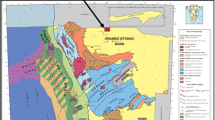Abstract
Geophagia is defined as deliberate consumption of earths’ materials, e.g. soil, clay and soft stones. The practice is widespread among pregnant women, and there are conflicting views as to whether it is beneficial to health or not. Geophagic materials may be a source of micronutrients though the materials may bind the micronutrients thus reducing or hindering their bioavailability in the body. Geophagia is closely associated with geohelminthic infections among pregnant women and heavy metal poisoning, which constitute significant public health problem in many developing countries such as Kenya. In our research, the geophagic materials consumed by the pregnant women were studied. A total of 38 geophagic materials in the possession by different pregnant women were analysed. The collected samples were subjected to standard digestion procedures and analysed for zinc, lead and iron by atomic absorption spectroscopy. Results indicated that the geophagic materials contained elevated levels of Fe at mean concentration value of 80.10 ppm, Pb at 3.28 ppm and Zn 1.81 ppm for a 1.00 g sample. An average of 20 g of the geophagic materials was being consumed per day. Based on the average consumption, the pregnant women were exposed to 65.52 ppm Pb per day, 36.2 ppm Zn per day and 1602 ppm Fe per day. Lead exceeded the WHO-lead exposure limits of 25 ppm/day for pregnant women. The materials were also subjected to microscopic examination for Ascaris lumbricoides, Trichuris trichiura, Taenia Spp., Necator americanus and Ancylostoma duodenale. In conclusion, the women were exposed to heavy metals—iron, zinc and lead, but there was no observable eggs, larvae or adult species of the geohelminths. The key recommendation was that there is need to integrate public health education on geophagia, lead screening and testing with antenatal support care systems. This will enhance maternal and child health, thus reducing infant and maternal morbidity and mortality rates.



Similar content being viewed by others
References
Abrahams, P., & Parsons, J. (1996). Geophagy in the tropics, a literature review. Geographical Journal, 162, 63–72.
Baker, P. N. (2006). Obstetrics by ten teachers. Manchester: BookPower.
Beard, J. L. (2008). Why Iron deficiency is important in infant development. Journal of Nutrition, 138(12), 2534–2536.
CDC. (2005). Blood lead levels-united states, 1999–2002 CDC, Weekly May 2005/54, pp. 513–516.
Cousins, R. J., & Hempe, J. M. (1990). Zinc. In M. L. Brown (Ed.), Present knowledge in nutrition. Washington: International Life Sciences Institute.
Giessler, A., Mwaniki, D., Thiongo, F., & Friis, H. (1997). Geophagy among school children in Western Kenya. Tropical Medicine & International Health, 2, 624–630.
Government of Kenya, KNBS. (2000). Demographic survey. Nairobi: Government of kenya Press Service.
Government of Kenya, KNBS. (2010). Population and housing census. Nairobi: Government of kenya Press Service.
Halsted, J. (1968). Geophagy in man; its nature and nutritional effects. American Journal of Clinical Nutrition, 21, 1384–1393.
Hansen, J., & Perry, B. (1987). The epidemiology, diagnosis and control of helminth parasites of ruminants. Addis Ababa: International Laboratory for Research on Animal Diseases.
Kibet, L. (2004). Use of environmental accounting to estimate optimal extraction levels for quarries: Case of Nakuru Municipality. Addis Ababa: Beijer Institute of Ecological Economics.
Luoba, A., Giessler, P., Estambale, B., Ouma, J. H., Magnussen, P., & Alusala, D. (2004). Geophagy among pregnant and lactating women in Bondo District, western Kenya. Transactions of the Royal Society of Tropical Medicine and Hygiene, 98, 734–741.
Middendorf, F., & Williams, P. (2000). Nephrotoxicity: Toxic responses of the kidney. New York: Wiley.
Mills, M. (2007). Craving more than food: The implications of pica in pregnancy. Nursing for Women’s Health, 11(3), 266–273.
Moturi, W. N., & Shivoga, W. A. (2009). Geophagia, a risk factor for diarrhoea in home environment: Study of Mauche division, Molo, Kenya. Journal of Infection Developing Countries, 3(2), 94–98.
Municipal Council of Nakuru. (1999). Census. Nairobi: Kenya National Bureau of Statistics.
Ngozi, P. O. (2008). Pica practices of pregnant women in Nairobi Kenya. East African Medical Journal, 85(2), 72–79.
Okalebo, J. R., Gathua, K. W., & Woomer, L. P. (2002). Laboratory methods of soil and plant analysis. A working Manual (pp. 22–24). Nairobi: TSBF-CIAT and Sacred Africa.
Patrick, Y. (2007). A case of geophagia (pp. 1–3). London: University College London, Clinical Vignette.
Sandstead, H. H. (1995). Is zinc deficiency a public health problem? Nutrition, 11, 87–92.
Sayetta, R. (1986). Pica: An overview. American Family Physician, 33, 181–185.
Shah, D., & Sachdev, H. P. (2006). Zinc deficiency in pregnancy and foetal outcome. Nutrition Reviews, 64(1), 15–30.
Shinondo, Cecilia, & Mwikuma, G. (2008). Geophagy as a risk factor for helminth infections in Lusaka, Zambia. Medical Journal of Zambia, 35(2), 50–51.
Villar, J., Klebanoff, M., & Kestler, E. (1989). The effect on foetal growth of protozoan and helminthic infection during pregnancy. Obstetrics and Gynecology, 74, 915–920.
WHO. (2000). Lead in: Safety evaluation of certain food additives and contaminants. Joint FAO/WHO expert committee on food additives, food additives Series: 44. Geneva: World Health Organization.
WHO. (2009). Global health risks: Mortality and burden of disease attributable to selected major risks. Geneva: World Health Organization.
World Health Organization. (2002). Prevention and control of schistosomiasis and soil-transmitted helminthiasis. Geneva: WHO.
Young, S. L., Goodman, D., Farag, T. H., Ali, S. M., & Khatib, M. R. (2007). Association og geophagia with Ascaris, Trichuris and Hookworm transmission in Zanzibar, Tanzania. Transactions of the Royal Society of Tropical Medicine and Hygiene, 101, 766–772.
Acknowledgments
The authors are grateful to the Departments of Chemistry and Environmental Science Egerton University for their technical assistance. They are also grateful to the Division of Research and Extension Egerton University for partially funding the project.
Author information
Authors and Affiliations
Corresponding author
Rights and permissions
About this article
Cite this article
Odongo, A.O., Moturi, W.N. & Mbuthia, E.K. Heavy metals and parasitic geohelminths toxicity among geophagous pregnant women: a case study of Nakuru Municipality, Kenya. Environ Geochem Health 38, 123–131 (2016). https://doi.org/10.1007/s10653-015-9690-3
Received:
Accepted:
Published:
Issue Date:
DOI: https://doi.org/10.1007/s10653-015-9690-3




